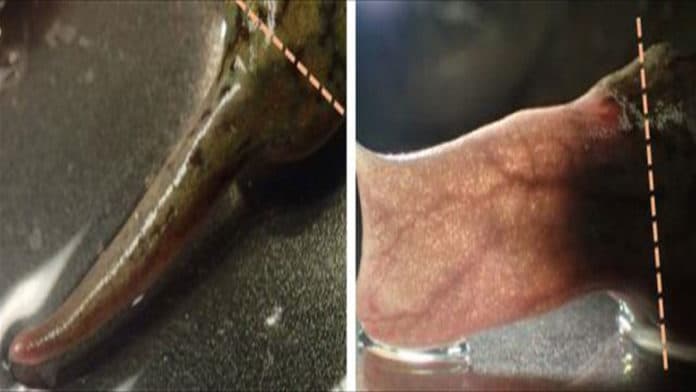A group of researchers has created a device that can incite partial hindlimb recovery in grown-up oceanic African ripped at frogs (Xenopus laevis) by “kick-starting” tissue repair at the amputation site.
The researchers 3D printed the bioreactor out of silicon and filled it with hydrogel- – a sticky glob of polymers. They bound the hydrogel with hydrating silk proteins that advance recuperating and regeneration at that point included progesterone. Progesterone is best known for its job in setting up the uterus for pregnancy, however, the hormone has likewise been appeared to advance nerve, vein, and bone tissue repair.
Senior author Michael Levin, a developmental biologist at the Allen Discovery Center at Tufts University said, “At best, adult frogs normally grow back only a featureless, thin, cartilaginous spike. Our procedure induced a regenerative response they normally never have, which resulted in a bigger, more structured appendages. The bioreactor device triggered very complex downstream outcomes that bioengineers cannot yet micromanage directly.”
Scientists categorized frogs in three groups: experimental, control, and sham. or the experimental and sham group, they sutured the device on the frogs immediately after limb amputation.
In the experiment group, the bioreactor discharged progesterone onto the amputation site. In all cases, they expelled the gadgets following 24 hours.
Scientists observed experimental group frogs at different time points over 9.5 months, they found that the bioreactor appeared to trigger a level of limb regeneration not observed in other groups. Rather than a normal spike-like structure, the bioreactor treatment brought about an oar like arrangement more like a full-fledged appendage than unaided recovery could make.
Scientists then took a closer look at the regenerated structures using molecular and histology analyses. They saw that, unlike in the control and sham groups, the regenerating limbs of the bioreactor-treated frogs were thicker with more developed bones, innervation, and vascularization. Analyzing video footage of the frogs in their tanks, they also noticed that the frogs could swim more like unamputated frogs.
RNA sequencing and transcriptome analysis revealed that the bioreactor had altered the gene expression occurring in cells at the amputation site. Genes involved in oxidative stress, serotonergic signaling, and white blood cell activity were upregulated, while some other signaling-related genes were downregulated.
The researchers also observed that scarring and immune responses were downregulated in the bioreactor-treated frogs, suggesting that the added progesterone dampened the body’s natural reaction to injury in a way that benefited the regeneration process.
Levin said, “The bioreactor device created a supportive environment for the wound where the tissue could grow as it did during embryogenesis. A very brief application of bioreactor and its payload triggered months of tissue growth and patterning.”
First author Celia Herrera-Rincon, a neuroscientist in Levin’s lab at Tufts University said, “In both reproduction and its newly discovered role in brain functioning, progesterone’s actions are local or tissue-specific. What we are demonstrating with this approach is that maybe reproduction, brain processing, and regeneration are closer than we think. Maybe they share pathways and elements of a common–and so far, not completely understood–bioelectrical code.”
Scientists are further continuing to target bioelectric processes for promoting spinal cord recovery and tumor reconstructing. They additionally want to duplicate their bioreactor experiments in mammals. Past research recommends that mice can halfway recover cut off fingertips in the correct conditions.
The study is published in the journal Cell Press.
